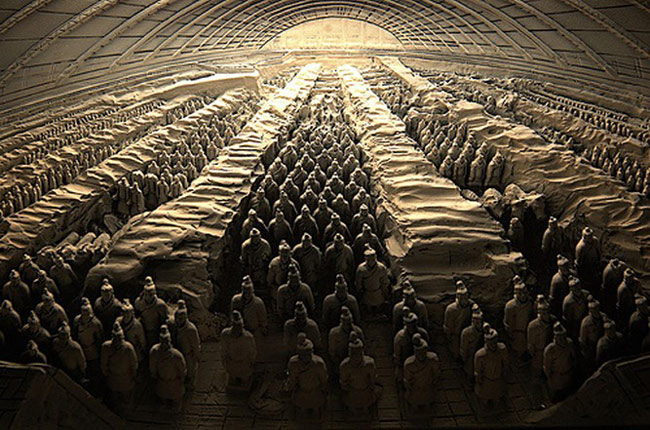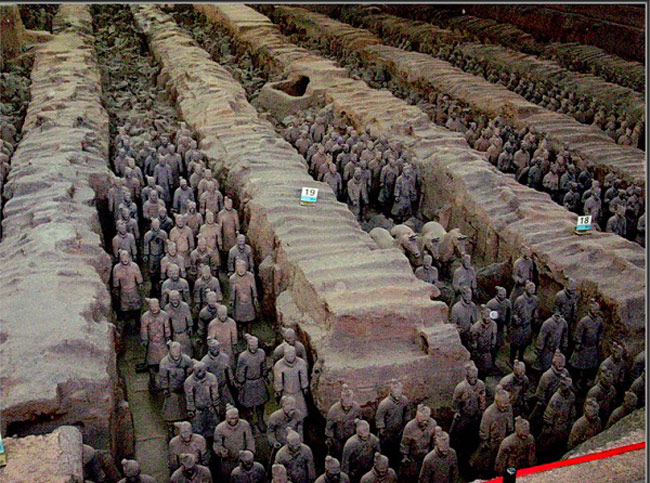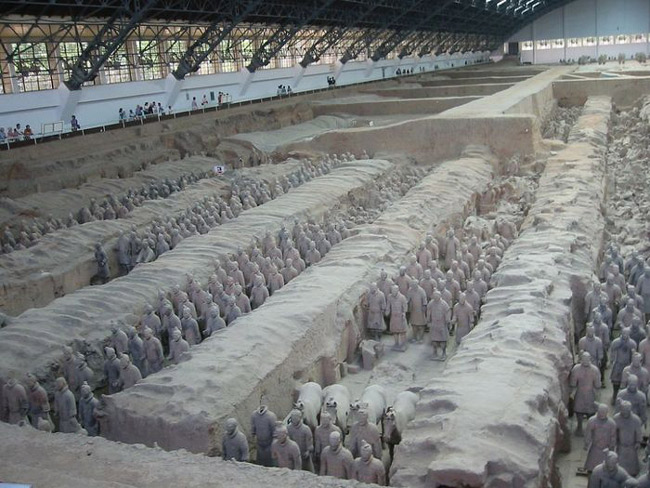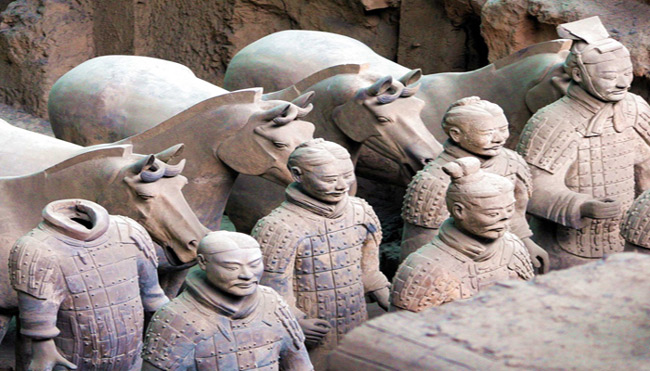Tomb of Qin Shihuang - China
The United Nations Educational and Cultural Science Organization has recognized China's Qin Shihuang Tomb as a Cultural Heritage in 1987.
Tomb of Qin Shihuang - World Cultural Heritage in China
The Tomb of Qin Shihuang is located north of Mount Lyshan, located in Shaanxi Province, 50 km east of Xi'an. On the grave is surrounded by a layer of floating soil 76 m high, from South to North 350 km long, from West to East 354 m wide.

On the ground around the tomb there are two layers of walls with an outer area of up to 2 km2. Between the two layers, there are long senses, imposing palaces, pagodas, houses . Below the ground is a rectangular palace of 460m long from South to North with 392m wide, from West to East, four sides with enclosed walls. The wall is 27m high, 4m thick, all sides have doors. The total area of the land is 180,000 m2.

 Large and grandiose in the tomb of Emperor Qin Shihuang.
Large and grandiose in the tomb of Emperor Qin Shihuang.
In the tomb from top to bottom there are three floors : the top floor is the outer palace, followed by the interior and finally the palace. The area covered with the bow is about 20,000 m2, in the palace, the scientists found mercury levels higher than normal by 280 times.
Outside the palace, there are 300 tunnels with over 5 thousand important objects . In the famous Chronicle of Sima Qian described the construction of the tomb of Qin Shihuang as follows: 'When Qin Shihuang was new to the throne, he dug the Ly Son mountain. Until the annexation of the galaxy, 70 thousand people in the galaxy moved to build a tomb, dig three streams, stay under the copper and put it in. Take the treasures of the palaces, places of offering, down to the store. Again, the shotgun maker named anyone who dug up and approached to shoot. Sai took mercury as a hundred rivers like Truong Giang, Hoang Ha and turned big. Machines make the river and sea water flow into each other. The above is astronomical enough, there is enough geography below, to take the fishman's head to build a torch to plan how to burn forever without turning off. After completing the tomb, Tan Nhi The (son of Qin Shihuang) wrongly closed the path to the tomb, filling the tunnel doors with all the builders of the last sections of the tunnel. Then plant many trees, grass up on the grave to form a hill ".

 The generals, warriors and terracotta war horses in the tomb of Qin Shihuang
The generals, warriors and terracotta war horses in the tomb of Qin Shihuang
Emperor Qin Shihuang or Qin Doanh Chinh (259-210 BC) crowned Qin Wang at the age of 13 and took control of the main dynasty at the age of 22. In 221 BC, Qin king counted 6 countries including the Department, Chu, Yen, Han, Zhao, Wei and first unified China. This is the first emperor in Chinese history . Immediately after the throne of Qin king at the age of 13, Qin Yuzheng mobilized 700,000 inmates to build a tomb for himself to ensure that he could rest in peace. The building was built for 38 years.
Because the tomb area is disguised as a hill, no one has discovered it for thousands of years. Until 1974, the tomb happened to be discovered when a farmer found broken pieces of old pottery. Subsequently, extensive excavations were carried out in 1974, 1985 and 2009.

In 1974, part of the tomb was excavated. The first is the Codec Tunnel, archaeologists estimate that there are 8000 statues made of clay including Quan Van, Quan Vo, soldiers and horses and servants of Qin Shihuang. In 1976, Hole 2 was discovered 20m from the first hole and then hole 3 was about 25m away from the first hole.
However, the excavation of the tomb was very difficult because the layer of mercury covered was too large, 280 times higher than the permitted level. Besides, scientists also have to move a huge amount of rock, and underground water level in the tomb is quite high, making excavation work more difficult.
Scientists and archaeologists work at the Tomb of Qin Shihuang. After being taken out of the ground, terracotta statues must undergo a preservation process to avoid cracking and then be put into storage with temperature in the environment maintained stably for preservation.

But the most important thing is the preservation of artifacts after they are brought up from the ground. The statues of soldiers when newly found have very specific colors, but after all, they have faded. So scientists decided to preserve it by 'dry-close' method to avoid cracking and fading. The excavated artifacts will be immediately put into the cold storage of about 40 degrees Celsius to create a thin layer of ice covering, then store in the long-term storage with modern equipment to maintain the temperature and environment. management.
After excavation, archaeologists said: Terracotta warriors and cavalry teams were arrayed according to the Qin army. Each warrior has a different height and face, even the expression on the face is not the same .
The Tomb of Qin Shihuang is one of the greatest archaeological finds in the world and was recognized as a world cultural heritage by UNESCO in 1987.







- China excavated the tomb of Qin Shihuang's grandmother
- The secret still covers the tomb of Qin Shihuang
- Discover treasure in the tomb of Qin Shihuang
- The mystery of the tomb Qin Shihuang
- The mystery of the weapons inside the tomb of Qin Shihuang - thousand years is still sharp
- Discovering foreign soldiers in the tomb of Qin Shihuang
- Found the palace in the tomb of Qin Shihuang
- The sophisticated weapon of the terracotta army in the tomb of Qin Shihuang
- Revealed more ancestral grave robbery Qin Shihuang
- China suspended excavation of the tomb of Qin Shi Huang
- The mysterious great grave of the eighteen generations of Qin Shihuang
- Excavating the tomb of Qin Shui Huang, discovering the animal world inside
 Suzhou classic bonsai garden - China
Suzhou classic bonsai garden - China Chau Nguyen Dynasty
Chau Nguyen Dynasty Thai Son Mountain - World Wonder
Thai Son Mountain - World Wonder Ancient villages of Shirakawa-go and Gokayama
Ancient villages of Shirakawa-go and Gokayama